Within the framework of 2023 FROGBEAR Phase 2 Cluster Activities, the leaders of Cluster 3.4 Typologies of Text-Image Relations organized International Research Workshop and Fieldwork “Chinese Religious Spaces in Thailand”.
Dates: May 24–June 2, 2023.
Cluster leaders: Christoph Anderl, in collaboration with Marcus Bingenheimer, Oliver Streiter, Tzu-Lung Melody Chiu, and Ngar-sze Lau.
Site(s): Chinese temples in Bangkok, Thailand.
Language(s): English; knowledge of Chinese is desirable; language support for Thai will be provided.
Summary:
Chinese temples in Thailand (and many other locations in South and Southeast Asia) give witness to the complex history of the spread of Chinese Buddhism, and the co-existence of various forms of Buddhism in that area. In the context of Thailand – although characterized by a dominance of Theravada Buddhism – there is a large number of Chinese temples especially in the Bangkok area, most of them clustering in and around Chinatown. Despite their Chinese heritage, many agents associated with the temples (monastics and laypeople) have fully integrated in Thai society and do not speak Chinese anymore (this seems to be a feature quite different from Chinese religious institutions in other countries where even after several generations the Chinese linguistic heritage is preserved). The temples still play a significant role for the religious and cultural life, as well as the identity, of communities with Chinese ancestors. Naturally, most of the temples cluster in and around Chinatown of Bangkok. This contemporary function of these religious institutions will be one focus of the fieldtrip, and we aim to document as many temples as possible with photographic (including 3D survey images) and video materials.
In addition, we will focus on a specific aspect of material culture extant in many of these temples, concretely, inscriptional / epigraphic materials. Chinese immigration to Southeastern locations started several hundred years ago, and the earliest inscriptions date back to the 17th century. In our work, we will focus on inscriptions predating the 19th century. Here, we build on the monumental work of Wolfgang Franke who in 1998 published a survey of epigraphic materials in Thailand. In our fieldwork, we aim to both trace Franke’s documented materials in the contemporary temples, document them with high-resolution images, in addition to complementing the records of Franke.
This will also enable us to gain an impression of the current condition of these materials, and their significance for religious practices and for the heritage / touristic activities of the individual temples. We will not only document materials in Chinese but also in Thai (or other languages such as Pali).
Participants and collaborators
The field trip is organized by Christoph Anderl (Ghent University), in collaboration with Marcus Bingenheimer, Oliver Streiter, Yoann Goudin, Elsa Ngar-sze Lau, and Chiu (Melody) Tzu-Lung. Without the immense preparatory work of and their vast experience in documenting Chinese temples in Taiwan and South and Southeast Asia of Bingenheimer, Streiter and Goudin, this fieldwork would not be possible. In addition to these specialists, we will be accompanied by ca. fifteen graduate students and PhD researchers from various universities, working in five groups. Each group will also include one local translator.
We are also in the fortunate situation to be supported by the Bangkok based Thammasat University who will help with the logistics and provide expertise for the training sessions and the fieldwork. Thammasat representatives will also accompany some of the fieldwork groups. We are especially indebted to Thomas Bruce, Paul McBain, John Johnston, and Ornthicha Duangratana for their support.
Schedule
May 23
Arrival of the participants
May 24 (Thammasat)
10:00-10:20 Christoph Anderl: “Welcome and brief introduction” / Welcome by Thammasat representative
10:20-10:50 Marcus Bingenheimer: “Chinese temples Bangkok – a survey” (lecture)
10:50-11:30 Paul Mcbain: “Introduction to reality scan, reality capture, 360 cameras, matterport” (training)
14:00-14:40 Oliver Streiter: “Following the Traces of Wolfgang Franke in Thailand: Impressions, insights and questions from out fieldwork in 2019 and 2023” (lecture)
14:40-15:20 Elsa Ngar-sze Lau: “Doing ethnographic research at religious site: observation and interview” (lecture)
15:40-17:00 Marcus Bingenheimer / Oliver Streiter: “Introduction to temple documentation, data collection, data input” (training / discussions)
May 25
09:00-12:30 FIELD WORK 1 in five groups
14:30 Gathering at Thammasat
14:30-15:20 John Johnston: “Contemporary Developments in Thai Buddhist Material Culture.” (lecture)
15:20-16:00 Melody Tzu-Lung Chiu: “Fieldwork practices and experiences in transnational Buddhist temples: Taiwan, Mailand China, Myanmar and Thailand.” (lecture)
16:00-16:40 Oliver Streiter: “How to identify objects (e.g., deities and symbols) in Chinese temples?” (training)
16:40-ca.18:00 Questions and discussion: Our experiences during the first fieldwork day
May 26 / 27 / 28 / 30 / 31 / June 1
09:00-17:00 FIELD WORK in five groups / work on fieldwork data
June 01 18:30-20:00 Lectures at Siam Society Bangkok
June 02
10:00-11:00 Paul Mcbain: “From a Buddhist utopia to a secular paradise: tracing changing ideals of the city of Bangkok from 1800-the present.” (lecture)
11:00-16:00 Final gathering and group reports / discussion of fieldwork data / Q&A / socializing)
June 03
Departure of the participants
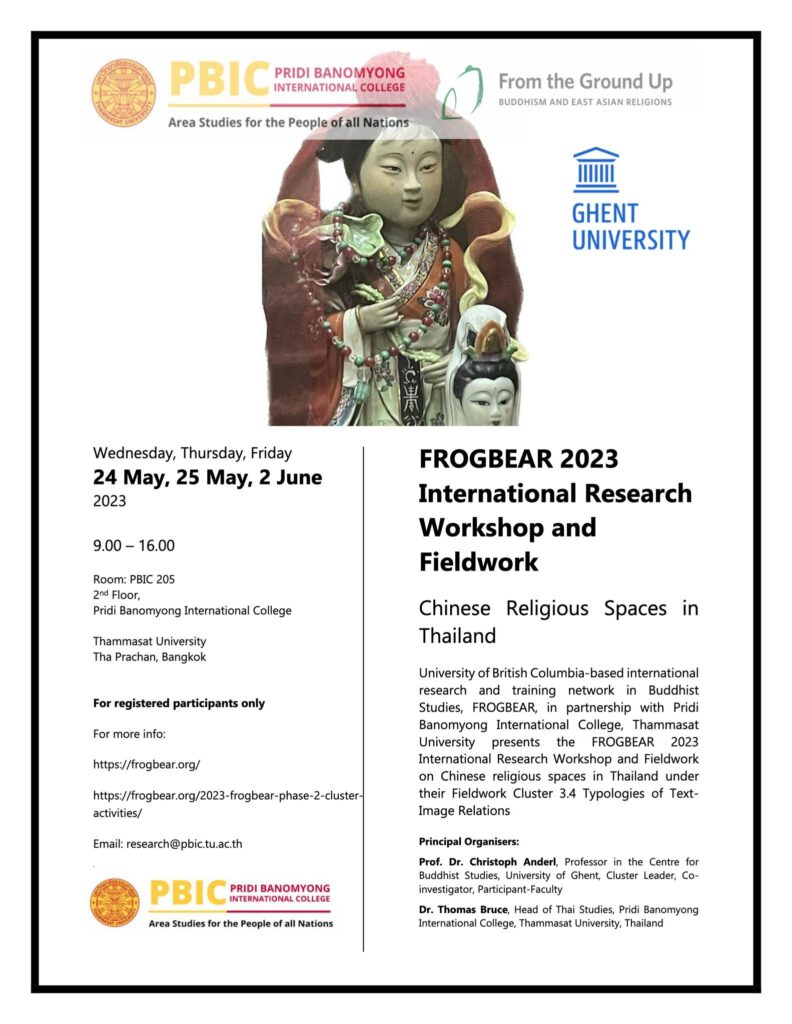
Below is a field report by team member Massimiliano Portoghese, PhD student at the Ghent Centre for Buddhist Studies.
Beyond Chinese Epigraphy in Bangkok: Spaces, Cults and Communities
In the English language, a sacred confined space for religious practice may be defined by the general descriptive term “temple.” However, everyday Thai language makes a clear distinction between a Buddhist monastic temple (Th. wat วัด), mostly belonging to Theravada institutions, and an alternative place of worship designed as a temple but not necessarily associated with just one religious tradition (Th. sanchao ศาลเจ้า). The latter often displays very syncretic trends drawing from Daoist, Buddhist, and local tutelary Chinese deities’ background. Moreover, it is always characterized by the absence of a residential monastic community.
Following the considerable flow of migration of several Chinese dialect communities (Teochew, Cantonese, Hakka, Hainanese, and Hokkien) to Siam from the seventeenth to the twentieth centuries, a large number of Chinese sanchao were established in the Bangkok metropolitan area. These religious sites were naturally linked to the cult of Chinese deities, and their distribution reveals the geographic development of Chinese merchant communities in Bangkok throughout the years (Ho 1995). Nowadays, these temples still play a significant role in Thailand’s religious and cultural life, as they have gained an established position within Bangkok’s social dynamics. Besides their religious functions, they also play a very important role in developing social connections. The widespread creation of associations (she 社) and charitable foundations linked to these temples have regularly helped local communities by building schools or providing medical support in difficult times. Most of the people engaged in the above-mentioned temple activities are now fully integrated into Thai culture, and they seem to have lost both their oral and reading skills in Chinese.
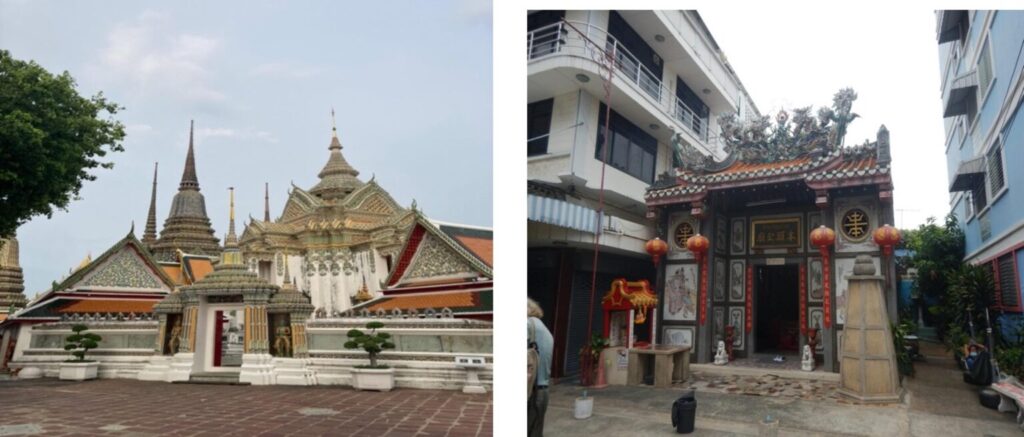
Currently, the large number of Chinese sanchao scattered around Bangkok face several threats. Their buildings struggle with issues such as humidity, flooding, dilapidation, and poor conditions. Natural factors combined with weak restoration programs and a lack of support from city planning are gradually leading these places of worship towards extinction. Given this situation, there is an urgent need for digital preservation and documentation of these endangered sites.
Among the few works published on Chinese temples in Bangkok, the key reference is Wolfgang Franke’s survey on Chinese epigraphic materials in Thailand dating back to 1998. Wolfgang Franke, the son of Otto Franke who was one of the most important founders of modern German sinology, dedicated himself to the study and documentation of Chinese epigraphy in Southeast Asia after retiring from his position (Chair of Sinology) at the University of Hamburg. Since Franke’s publication, only a few studies have focused on epigraphy in Thailand, mostly on inscriptions found on temples (City Planning Department Bangkok Metropolitan Area 2016; Duan 1996).
To address these research gaps, Christoph Anderl of Ghent University led a field trip to Bangkok from May 23 to June 3 2023, as part of the FROGBEAR (From the Ground Up: Buddhism and East Asian Religions) project Research Cluster 3.4 “Typologies of Text-Image Relations.” This project benefited from parallel investigations conducted by Marcus Bingenheimer (Temple University) and Paul McBain (Thammasat University), who produced 3D photography and VR modeling of Chinese temples in Bangkok, and by Oliver Streiter (National University of Kaohsiung) and Yoann Goudin’s (Université Jean Moulin Lyon 3) Thakbong Project, which focused on re-documenting and enriching the materials collected by Franke (Streiter, Bingenheimer, Zhan, To, and Shih 2019). Other specialists in fieldwork studies in Chinese Buddhist communities, such as Tzu-Lung Chiu 邱子倫 (National Chengchi University) and Ngar-Sze Lau 劉雅詩 (Chinese University of Hong Kong), joined the project by lending their fieldwork expertise and leading two of the five groups of researchers involved in the task.
When examining Franke’s black-and-white photographs collected twenty-five years ago, several research questions arise: What is beyond epigraphy? What it can tell us about social history and the development of Chinese religious communities in Bangkok? What has been preserved? What has been lost? What has been added? How many sanchao can be counted, and where are they located? Additionally, researchers should question the status of these sacred places: who is responsible for their maintenance? What is their significance for religious practices and why are they located in their respective neighborhoods? How do we identify and classify the wide range of objects found inside the temples? Lastly, how do we approach the concept of “Chineseness” in relation to these temples?
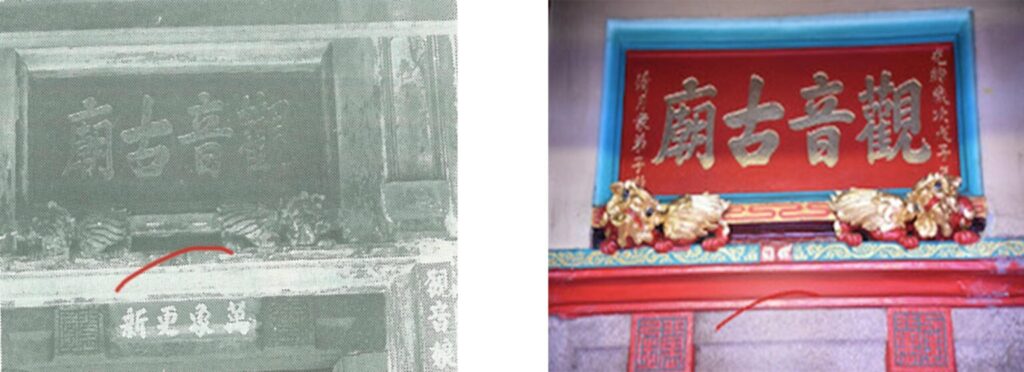
The pantheon of deities featured in the Chinese sanchao is very heterogeneous, including Buddhist deities, tutelary gods, characters from Chinese history and literature, idols from popular religions, Daoist immortals, and even Indian-derived divinities such as Gaṇeśa, Brahmā, and Śiva. However, each temple tends to place special emphasis on one deity. The main god is typically located on the largest altar, while other divinities are scattered throughout the inner and outer spaces of the temple in the form of statues and paintings. Consequently, the researchers participating in the fieldwork were divided into five groups, with each group visiting temples associated with one main god or goddess: Guanyu 關羽/Guandi 關帝; Bentougong 本頭公; Guanyin 觀音; Mazu 媽祖/Tianhou 天后; and Xuan Tian 玄天. Collaborative efforts of the five groups revealed intersecting repertoires of deities and ritual practices within communities affiliated with diverse temples. Rich epigraphic material from the last two centuries still survives within Chinese sanchaos and graveyards in Thailand, particularly in the Bangkok area, and provides valuable insights into how various Chinese dialect immigrants adapted and thrived in the Thai environment.
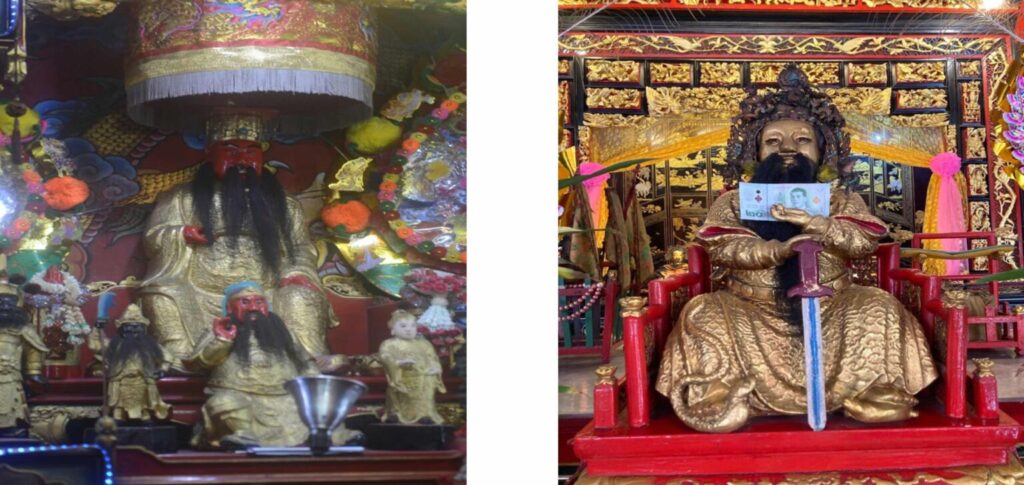
During the ten days of fieldwork, the FROGBEAR research team documented over fifty temples by collecting high-quality images (including 3D images) and conducting interviews with practitioners and caretakers. The data is publicly accessible in FROGBEAR’s open-access databases to ensure preservation and free access to the documented materials for scholars and the general public alike. This fieldwork shaped the basis for an extensive dynamic archive of religious sites that can be further explored from various angles. However, there is still a great deal of further investigation and survey work to be undertaken. With threats such as pressure for relocation, inadequate funding, and a declining number of caretakers maintaining the temples, these sacred sites face significant risk of becoming lost. More research surveys and support are strongly encouraged to help preserve these Chinese sanchaos, and to ensure that they do not disappear from Bangkok’s diverse social, cultural and religious heritage. If these traditions fade away, their physical spaces will also be at risk of being lost.
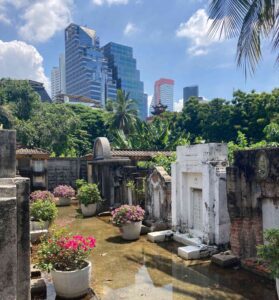
Bibliography
City Planning Department Bangkok Metropolitan Area. 1996. Chinese Shrines: The Faith of Bangkok. Bangkok: Bangkok Metropolitan Administration.
Duan Lisheng 段立生. 1996. Taiguo de zhongshi simiao 泰國的中式寺廟. Bangkok: Taiguo Datongshe chuban youxian gongsi 泰國大同社出版有限公司.
Franke, Wolfgang 傅吾康, and Chen Tieh Fan 陳鐵凡. 1982–1987. Chinese Epigraphic Materials in Malaysia 馬來西亞華文銘刻萃編, vols. 1–3. Kuala Lumpur: University of Malaysia Press.
Franke, Wolfgang 傅吾康, Xiao Guojian, and Claudine Lombard-Salmon 蘇爾夢. 1988–1997. Chinese Epigraphic Materials in Indonesia 印尼華文銘刻彙編, vols. 1–3. Singapore: South Seas Society 南洋學會.
Franke, Wolfgang 傅吾康, and Porpan Juntaronanont 劉麗芳. 1998. Chinese Epigraphic Materials in Thailand 泰國華文銘刻彙編, vols. 1–2. Taipei: Xinwenfeng chuban gongsi 新文豐出版公司.
Ho, Chuimei. 1995. “Chinese Temples in Bangkok. Sources of Data for 19th-Century Sino-Thai Communities”. Journal of The Siam Society 83, no. 1–2: 25–43.
Streiter, Oliver, Marcus Bingenheimer, Hanna Ya-Qing Zhan, Mandy Manwai To, and Syuan Fei Shih. 2019. “First Steps Towards Reviving Franke’s ‘Chinese Epigraphy in Southeast Asia’: Motivations, Approaches and Data Structures”. In Documenting and Researching Graveyards in Pacific Asia: Migration, Religion and Ethnicity (DRGPA2019): Proceedings, edited by Oliver Streiter, Man Wai To, and James X. Morris, 91–118. Taipei: Academia Sinica.